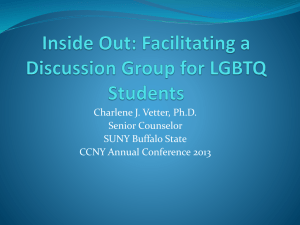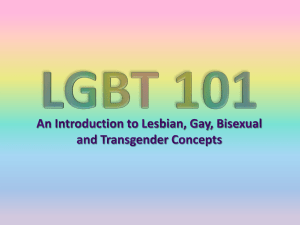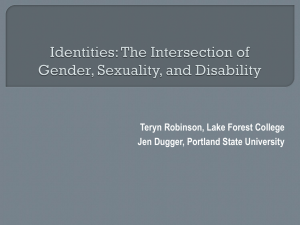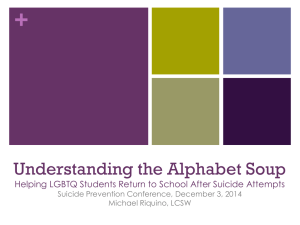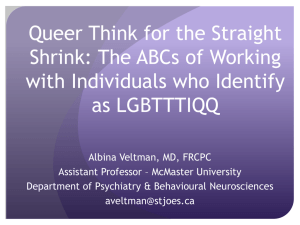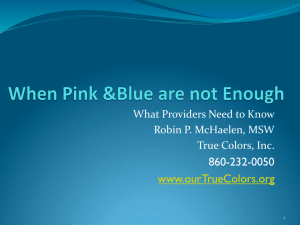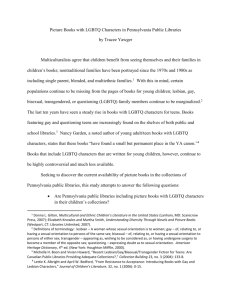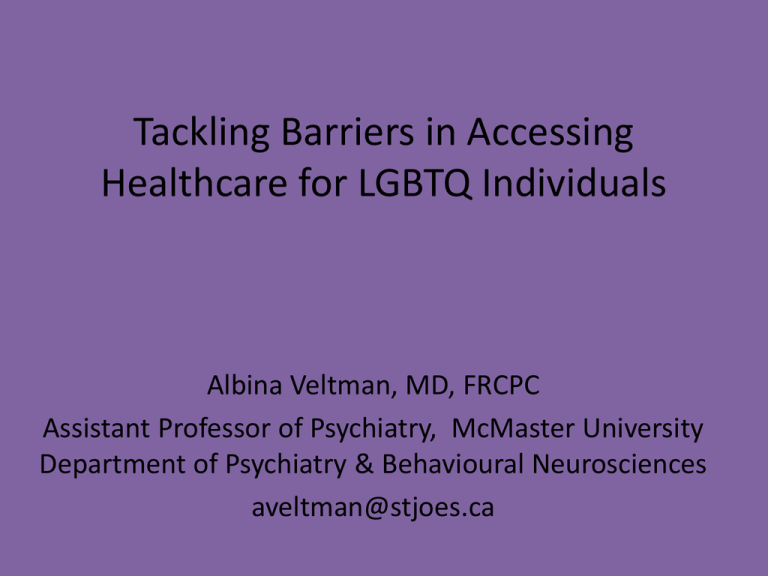
Tackling Barriers in Accessing
Healthcare for LGBTQ Individuals
Albina Veltman, MD, FRCPC
Assistant Professor of Psychiatry, McMaster University
Department of Psychiatry & Behavioural Neurosciences
aveltman@stjoes.ca
Objectives
• Understand the terminology related to LGBTQ
communities
• Gain knowledge regarding some of the specific
health care needs of LGBTQ individuals
• Understand the barriers that LGBTQ individuals face
in accessing healthcare
• Gain knowledge regarding how to reduce healthcare
access barriers
The ABCs of LGBTTTIQQ
communities
•
•
•
•
•
•
•
•
•
Lesbian
Gay
Bisexual
Transgender
Transsexual
Two-spirit
Intersex
Queer
Questioning
Other Important Terminology
• Sexual orientation: how one identifies their sexual
attraction and affection, both physical and
emotional
• Gender identity: a person’s deep sense of being
male, female, neither or both
• Heterosexism: assumption that everyone is or
should be heterosexual
• Ally: a person who is not a member of a specific
group, but who supports that group, challenges
discrimination and oppression of that group, and
explores their own biases
“When I went to an addiction treatment clinic, the
nurse asked me, ‘What’s the name of your
husband?’ I said, ‘I don’t have a husband’. ‘Okay’,
she then asked, ‘is it your boyfriend?’ I said, ‘I have
a partner’. She said, ‘What’s his name?’ When it
comes to these questions, it’s so uncomfortable. I
don’t make it a big deal myself. I just said, ‘Her
name is Sharon’. But then you can see their faces
changing. Then you feel uncomfortable for the rest
of the questions.”
Kinsey Scale
Holistic Approach
• LGBTQ people have the same health concerns as anyone
else, as well as some additional risk factors
• Important to engage the whole person, do not treat
patients like a collection of risk factors
• Important to understand that life issues for people who
are LGBTQ are similar to everyone else:
– Work stressors
– Financial issues
– Long Term Relationships
– Parenting
– Aging
7
Special Considerations in LGBTQ Patients
• Increased vulnerability due to:
– Burden of maintaining a secret/double
identity
– Loss of supports/isolation
– Bullying/violence
– Discrimination/Heterosexism/Genderism
– Coming out process
– Internalized homophobia
– Pathologization by the medical/psychiatric
community
Special Considerations in Transgender
Patients
• Trans individuals report that health care professionals:
– Have serious misconceptions about trans people
– Confuse transgender and gay/lesbian identities
– Appear uncomfortable providing services and treated them
differently once they became aware of their trans identity or
history
• Trans individuals also felt vulnerable around the fact that their
hormones and overall care could be ended abruptly; this in turn
affected what they felt comfortable telling their health providers.
• http://www.transpulse.ca/documents/Trans_PULSE_Phase_I_Report.pdf
Specific Health Care Needs of Gay and
Bisexual Men
Ten Things Health Care Providers should Discuss with
their Gay or Bisexual Male Patients
1. HIV/AIDS, Safe sex
6. Prostate/Testicular/Colon cancer
2. Substance Use
7. Alcohol
3. Depression/Anxiety
8. Tobacco
4. Hepatitis Immunization 9. Fitness (Diet and Exercise)
5. STDs
10. Anal Papilloma
All men who have sex with men (MSM) should be vaccinated
for Hepatitis A and Hepatitis B.
http://www.glma.org/news/releases/n02071710gaythings.html
Specific health care needs of Lesbian
and Bisexual Women
Ten Things Health Care Providers should Discuss with
their Lesbian and Bisexual Female Patients
1. Breast Cancer
2. Depression/ Anxiety
3. Gynecological Cancer
4. Fitness (Diet and Exercise)
5. Substance Use
6. Tobacco
7. Alcohol
8. Domestic Violence
9. Osteoporosis
10. Heart Health
http://www.glma.org/news/releases/n02071710lesbianthings.html
Specific Health Care Needs of
Transgender Individuals
Ten Things Health Care Providers should Discuss with
their Transgender Patients
1. Access to Health Care
2. Health History
3. Hormones
4. Cardiovascular Health
5. Cancer
6. STDs and Safe Sex
7. Alcohol and Tobacco
8. Depression/Anxiety
9. Injectable Silicone
10. Fitness (diet & exercise)
http://www.glma.org/_data/n_0001/resources/live/Top%20Ten%20Trans.pdf
Specific Health Care Needs of Intersex
Individuals
• Intersex Society of North America’s Recommendations for
Treatment
• http://www.isna.org/node/138
• The American Academy of Pediatrics recommends when
deciding the sex of rearing of a baby with ambiguous
genitalia, one should consider fertility potential, capacity for
normal sexual function, endocrine function, potential for
malignant change, testosterone imprinting, and timing of
surgery.
• http://aappolicy.aappublications.org/cgi/reprint/pediatrics;118/2/e488.pd
f
LGBTTTIQQ Youth statistics
• Nine out of 10 LGBT students experience
harassment at school (vs. 62% of non-LGBT
students)
• 60% of LGB students feel unsafe at school because
of their sexual orientation.
• Lesbian, gay, and bisexual adolescents are almost
twice as likely to use drugs and alcohol than are
heterosexual teens.
• It is estimated that between 20 and 40 percent of
all street-involved youth identify as lesbian, gay,
bisexual, and/or transgender.
LGBTTTIQQ Youth suicide
• Lesbian, gay, and bisexual youth are up to four times
more likely to attempt suicide than their heterosexual
peers.
• More than 1/3 of LGB youth report having made a
suicide attempt.
• LGB youth who come from highly rejecting families are
more than 8 times as likely to have attempted suicide
than LGB peers who reported no or low levels of family
rejection.
• Of all completed youth suicides, approximately 30%
self-identified as lesbian, gay or transgender.
Barriers to Accessing Health Services for
LGBTQ Individuals
• Discomfort/fear of disclosing LGBTQ status due to
real or perceived
Homophobia/Biphobia/Transphobia
• Patient’s own internalized
homophobia/biphobia/transphobia
• Provider ambivalence/discomfort related to
inadequate education re: LGBTQ issues
• Heterosexist assumptions on forms/interviews
Barriers to Accessing Health Services for
LGBTQ Individuals
• Pathologization of LGBTQ status (consideration of
sexuality/gender status as part of illness, history of
homosexuality and gender identity disorder in the
DSM)
• Previous experiences or stories of
“corrective/reparative” therapies
• No opportunity for disclosure – providers not asking
the right questions
• “Dual alienation”
Dual Alienation
• ‘I’m not really all that accepted in the mental
health patient community because I’m a
lesbian and I’m not accepted in the lesbian
community because I’m a mental health
patient. I don’t feel like I belong anywhere.’’
Dual Alienation
“The LGBTTTIQ community is already
marginalized. The mental health community is
already marginalized. When you belong to two
marginalized groups, you become that much
further marginalized.”
Pathologization of LGBTTTIQQ
communities
• History of homosexuality in the DSM
• Consideration of sexuality/gender status as part of
illness
• Expectation of increased rates of psychiatric
diagnoses
• Inclusion of Gender Identity Disorder in the DSM
– Requiring diagnosis for hormone/surgical
treatments
Pathologization
“I’ve had several doctors and nurses tell me that
I must be depressed because I’m a lesbian and I
haven’t dealt with that. That’s bullshit. I was a
happy, out, and proud-in-a-relationship lesbian
before I got depressed for the first time. I don’t
think it has anything to do with my being gay.”
Gender Identity Disorder in the DSM:
The Controversy Continues
• Many Transgender activists/individuals want GID to
be removed from the DSM
• WPATH and CPATH (World/Canadian Professional
Associations for Transgender Health) support the
removal of Gender Identity Disorder from the DSM
• If not under psychiatry’s umbrella, who will
diagnose/treat? How will individuals received the
treatment they need and want without a diagnosis?
Dismissiveness/“Neutrality”
• Dismisses the potential importance of sexuality
as a part of the client’s identity
• Doesn’t take into account the experience of the
individual
Positive Experiences with Providers
•
•
•
•
Can facilitate recovery in general
Can facilitate process of coming out
Greatly increases sense of connection and self-worth
Can be extremely helpful when provider is queer, but
not a necessity
• Importance of linkages with community
“When a nurse shared that she was a lesbian: It made me feel less
ashamed. It was because she is a nurse and she is gay and there is nothing
wrong with that. I didn’t have to be ashamed for being gay.”
Negative Experiences with Providers
• Negative impacts of stigma and lack of
understanding on clinical work:
• Overemphasis on LGBT identity
• Lack of understanding > irrelevant lines of inquiry and focus
• Regarding LGBT as a result of mental illness
• Complicates/hinders recovery process
“There was one doctor who asked me ‘If you have children, how can you
be a lesbian?’”
• Bottom line: Lack of client-centred care
Client-Centred Care
“When I go see my family doctor, or my psychiatrist, or a
nurse, especially about something very important, I don’t
want them to treat me clinically as if I was just a walking
disease in front of them. I want them to treat me like a
real person. A whole person. I’m more than a walking
disease or disorder. I have feelings. I have a family. I have
friends. I have goals and dreams. I want them to make me
feel like I matter, that all of that stuff means something to
them. That they really care. If all health care folks treated
their patients that way, there would be no issues about
feeling discriminated against, stigmatized, or ignored.”
LGBTQ Persons’ suggestions for
improvements in service delivery
•
•
•
•
•
Services that are LGBT only
Specific groups for LGBT consumers
Having an LGBT-specific provider
Better referrals/linkages with community resources
Environment in which providers are out and dialogue is
open
• Environment of client-centred care and professionalism
Defining
Care
• LGBT-tolerant
Aware that LGBT people exist and use their services
• LGBT-sensitive
Aware of, knowledgeable about, and accepting of LGBT
people
• LGBT-affirmative
Actively promote self-acceptance of an LGBT identity as a key
part of health and recovery
Allies
• If you’re not LGBTQ
yourself, become
an ally.
What constitutes a positive space?
•
•
•
•
•
Inclusive language
Lack of assumptions
LGBT posters/pamphlets/signs
Respect
Acceptance and celebration of diversity
How do you use inclusive language?
•
•
•
•
Asking the Right Questions – CAMH
Use gender neutral language – no assumptions!
Reflecting back language used by client
Normalizing the questions
Think!
• What can you do to
improve health
care access and
services
for LGBTQ
individuals in your
community?
What can you do to improve the
situation?
•
•
•
•
Reflect on your own reactions and feelings
Examine your own language use
Educate yourself – take action to be an ally
Speak up when you see discrimination, insensitivity,
gaps in knowledge and action
• Advocate for policy changes that are LGBTQaffirmative
• Include gender identity and sexual orientation in a
zero-tolerance discrimination policy at your
facility/organization
Think!
• Do your beliefs about
sexuality and gender
identity negatively
affect the health care
you provide for your
patients?
• Do you feel that you
know the health care
needs of LGBTQ
patients?
Biases in Health Care Forms/Interviews
• Do the forms in your medical
clinics have boxes that only offer
the choices: single/ married/
widowed/ divorced?
• When a female patient says that
she is sexually active, is the next
question automatically “What
are you using for birth control?”
• Are the only choices on your
forms under gender, male or
female?
LGBTQ-Affirmative Care
• Instead of boxes for gender, have a blank line where patients
can identify themselves as they choose, not in the rigid
categories that you choose for them.
• When asking about sexual behaviour, ask “are you sexually
active with men, women, or both?” And then, only if
appropriate, ask about birth control.
• Ask all your patients about domestic violence using the terms
“partner, family member, or caretaker” instead of “boyfriend
or husband”.
LGBTQ-Affirmative Care
• When treating a transgender individual, use the pronoun
appropriate to their preferred gender. If unsure, always ask
your patients what pronoun they prefer.
• Don’t make assumptions about your patients based on their
stated gender or sexual identity.
• Use gender-neutral language(e.g. partner, significant other).
• Encourage your patients to include their family of choice in
their health care.
TREATMENT DO'S AND DON'TS
DO’S
• Use the proper pronouns based on client’s selfidentity when talking to/about transgender
individuals.
• Allow transgender clients to continue the use of
hormones when they are prescribed. Advocate that
the transgender client using “street” hormones get
immediate medical care and legally prescribed
hormones.
• Allow transgender clients to use bathrooms and
showers based on their gender self-identities.
TREATMENT DO'S AND DON'TS
DO’S
• Ask all clients about their sexual orientation and
gender identity.
• Be guided by your LGBTQ clients. Listen to what they
say is comfortable for them.
• Acknowledge clients’ significant others and
encourage their participation in treatment.
• Require all clients and staff members to create and
maintain a safe environment for all LGBTQ clients.
• Post a non-discrimination policy in the waiting room
that explicitly includes sexual orientation and gender
identity.
TREATMENT DO'S AND DON'TS
DON’TS
• Don’t call someone by pronouns that they do not identify
with.
• Never make a transgender patient choose between
hormones and treatment and recovery.
• Don’t make a transgender patient be responsible for
educating staff.
• Don’t assume that individuals who are transgender are gay.
• Don’t make transgender individuals use bathroom facilities
that are incongruent with their preferred and presenting
gender.
• Never allow staff members or clients to make transphobic
comments.
TREATMENT DO'S AND DON'TS
DON’TS
• Don’t label your clients.
• Don’t pressure clients to come out. Respect their
sense of where they are in this process and their
need to feel safe.
• Don’t ignore significant others and family members.
• Don’t interpret on behalf of the client, e.g., “It must
be hard being a lesbian,” or “You must be angry
because your parents don’t accept your being a
person of transgender experience.” Instead, follow
your client’s lead.
Resource for Transgender Individuals and
Clinicians: “True Selves” by Mildred Brown
LGBTQ Resources for Clinicians
Web Resources
• www.thewellhamilton.ca – The LGBTQ Community
Wellness Centre of Hamilton website contains information
regarding local resources and events
• www.rainbowhealthontario.ca – Ontario-wide resource
for LGBTQ health
• http://www.camh.net/Publications/Resources_for_Profes
sionals/ARQ2/arq2.pdf - Asking the Right Questions
Manual from CAMH – helpful resource for knowing how
to ask questions regarding sexuality and gender identity
• www.pflag.org – Parents and Friends of Lesbians and Gays
– Organization that supports families and friends of
LGBTQ individuals.
• www.thetrevorproject.org – The Trevor Project – Suicide
Prevention for the LGBTQ community
Web Resources
• www.fenwayhealth.org - The Fenway Institute works to make
life healthier for those who identify as LGBTQ, people living
with HIV/AIDS, and the larger community.
• http://www.glma.org - The Gay and Lesbian Medical
Association exists to maximize health care for LGBTI
individuals.
• www.transpulse.ca - The Transpulse Project website contains
information regarding a recent study of health care disparities
within the transgender community.
• http://www.transgendercare.com/default.asp TransgenderCare is a website designed to help those looking
for a better understanding of male to female transitioning.
Web Resources
• http://www.gender.org - Gender Education and Advocacy is a
U.S. National organization focused on the needs, issues, and
concerns of gender variant people in human society.
• http://www.wpath.org - The World Professional Association
for Transgender Health is a professional organization devoted
to the understanding and treatment of gender identity
disorders.
• http://www.isna.org - The Intersex Society of North America is
devoted to systemic change to end shame, secrecy, and
unwanted genital surgeries for people born with an anatomy
that someone decided is not standard for male or female.
Questions?
He who asks a question is a fool for five minutes
He who fails to ask a question is a fool for life
Old Chinese Proverb

